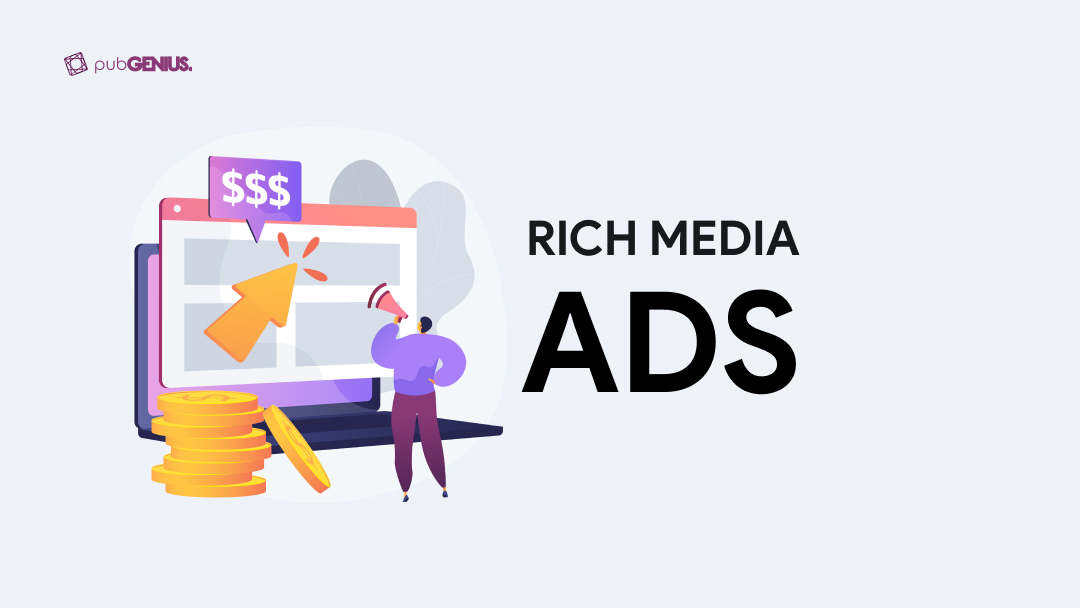Rich Media Ads - Why They Are Better Than Static Banners
August 24, 2021
Rich media ads.
What are they exactly?
As you probably know, the effectiveness of traditional banner advertising has been declining. Since the early 2000s, when the digital advertising market started its exponential growth, the volume of banner ads Internet users are exposed to daily keeps growing. It is estimated that today the average user is served more than 2000 banner ads per month. So it’s no wonder that the average click-through rate (CTR) of banner advertising is getting lower each year while so-called banner blindness is on the rise.
Banner blindness can be a big problem for online publishers as it leads to falling CTR (currently it’s estimated to be around 0.14% on average) and declining CPM (cost per thousand) as a result. And even modern-day targeting technologies that make banner ads as relevant for the audience as possible doesn’t help much.
One of the ways to deal with this problem is to use programmatic ad tools and cutting edge ad formats. Such as rich media ads, which is what we are going to talk about today.
What are rich media ads?

Rich media ads is a format of online advertising that implies a combination of multiple kinds of rich media, such as text, images, video, animation, audio, etc., within one banner. These ads are dynamic in nature and can be activated by user behavior or actions on the website. The intention behind rich media ads is to make traditional banners more interactive.
Even though rich media ads were first introduced back in late 1990s, they really started to gain popularity throughout the last decade or so, serving as a new way to gain user attention and increase engagement.
The ability to adapt to the user’s device and activity is a crucial distinctive feature of rich media ads. In particular, they can move along when the user is scrolling, change positions on the page depending on user activity, expand when touched by the cursor, rotate, and so on.
Combined with the ability to combine various formats, rich media ads are capable of providing a more entertaining and positive user experience, leaving a lasting impression.
Rich media ads vs. Standard banners

Let’s take a look at the main differences between rich media ads and standard banners.
-
Interactivity.
Standard banners are static, while rich media ads are dynamic and able to react to users’ actions.
-
Media formats.
Standard banners are limited to using only text or image. Rich media ads also support all the other kinds of media.
-
Reaction to clicks.
When a user clicks on a standard banner, it typically leads to the advertiser’s website or promo page. With rich media ads, advertisers have much more options, as clicks may lead to the activation of sound or video, banner expansion. etc
-
Ad size and formats.
When static banners are typically limited to 200 KB as maximum size and rely on .GIF as the main format, rich media ads have greater size and support multiple different formats.
-
Web technology support.
Unlike traditional banners, rich media ads are compatible with all modern Web technologies, such as HTML5, Javascript, and Java.
-
Ad performance measurement.
The measurement of the ad performance is another difference of these formats that can benefit a publisher. While standard banners only rely on CTR, rich media ad performance can be measured with multiple other metrics, such as user engagement.
Benefits

Even though the main strengths should be rather clear now, it may not be totally obvious how you can benefit from implementing them as a publisher. Here are a few points.
-
Higher demand from advertisers.
Every year rich media ads are getting more popular among advertisers while traditional static banners are losing their market share. This is why the ability to serve rich media ads can significantly expand the demand for your ad inventory and the number of advertisers interested in buying your ad impressions.
-
CTR improvement.
The introduction of rich media ads normally allows advertisers to improve CTR considerably. Even though real results would heavily depend on the quality of your rich media ads, targeting settings and some other factors, usually enabling dynamic interactive advertisement on your website results in CTR improvement at 20-25%.
-
Great source of performance measurement data.
As we mentioned earlier, using rich media ads allows you to gather a lot more ad performance stats compared to static banners that are limited to CTR only. Dynamic ads can be a source of multiple kinds of measurements based on user interaction with banners, such as display time, conversion rate, expansion rate, etc. All this data can and should be used to improve ad sales strategy and make the adjustments allowing to maximize your CPM.
-
Better ad diversity and user engagement.
The fact that rich media ads support combinations of different media makes this format much more suitable for creation of original and unique ads. This is an advantage for advertisers looking for better performance in terms of customer engagement and view-through rates.
How to create rich media ads?

There are multiple tools and platforms enabling easy creation of rich media ads available for publishers and advertisers.
Here are some of the most popular ones:
Summary
Making rich media ads a part of your ad inventory would be a smart move if you want to increase the demand for your ad inventory and improve the performance of your ads. But the real effect from the integration would heavily depend on the quality and the way the ads are designed to interact with your audience. While the availability of advertisers willing to place their interactive ads on your websites would depend on the choice of media ad networks and other platforms you are using to sell your ad inventory.
Not sure where to start and how to integrate dynamic ads into your website? Don’t have time and energy to dive deep into the specifics of various digital ad formats and platforms? Allow professionals with proven expertise in the digital ads market to take care of this.
This is us! pubGENIUS’ ad ops specialists are well-versed in the best practices and trends of the industry. We know how to utilize innovative technologies and ad formats to optimize the ad sale process and achieve maximum revenues.
Get in touch with pubGENIUS Team to get free consultation 🙂
